A conversation with Andrew Peregrine, project manager for Modiphius Entertainment’s new tablet roleplaying game Dune: Adventures in the Imperium, very quickly goes off-topic. The problem is that in addition to being a massive geek (“We haven't even started to unpack that you've got a Fourth Doctor scarf behind you,” he notes) he's a roleplaying lifer – a roleplaying evangelist, even.
But being fluent in both these languages is a huge part of what makes Dune: Adventures in the Imperium so elegantly poised when it comes to serving the book’s many (games)masters at arguably the most high-profile period for Frank Herbert’s sprawling space opera.
For a start, there’s Legendary Entertainment, the production company behind The Dark Knight (2008), Jurassic World (2015), Godzilla vs. Kong (2021), and – of course – Denis Villeneuve’s Dune movie. They’re the immense and elemental sandworm rumbling beneath the surface, ready to swallow up everyone involved like Fremen finger food. Then there’s the estate of the late Frank Herbert, the literary originator of the Dune way back in 1965 and a huge influence on everything from Star Wars (sandworms, desert worlds, mystic monastic orders) to Warhammer 40,000 (psychic navigators, immortal emperors, doomy medievalism). Its current custodians, novelists Brian Herbert and Kevin J. Anderson, are continuing to build on this already richly layered world with the second in the Caladan prequel trilogy and the 16th Dune book they’ve written together, Dune: The Lady of Caladan.
There’s also Modiphius’s reputation for high quality, luxuriously packaged, and inventive interpretations of existing works – the catalog includes Star Trek Adventures, Robert E. Howard’s Conan: Adventures in an Age Undreamed Of, and Fallout: The Roleplaying Game. There are exceptions to every rule of course, but licensed roleplaying games once had a reputation for taking press material and production photographs, and winching them into the tight-fitting trousers of an open-license game system. It’s notable that two of the most celebrated examples, West End Games’ Star Wars, and FASA’s Star Trek, were both introduced at a time (1987 and 1982) when the canon was effectively dormant and the publishers were left to their own devices.
Not so Dune. Oh god-emperor, no.
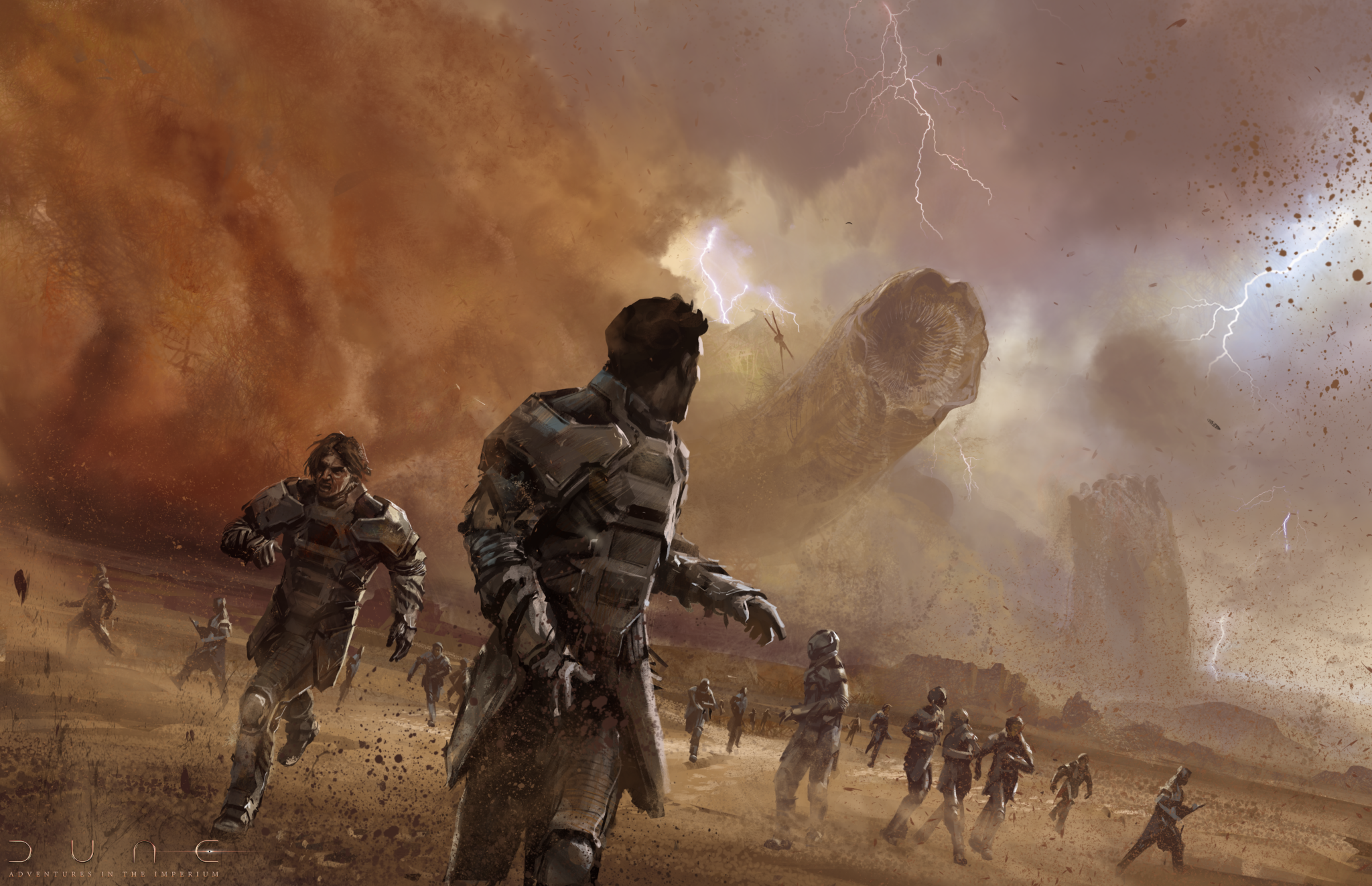
Deciding on the Focus For the Dune RPG
Last but not least, there are the players themselves who might fall anywhere the piece of graph paper plotting RPG knowledge and Dune knowledge, and then exposure to the movie (or the David Lynch movie, or the two Sci-Fi Channel miniseries) or the books (and then there’s the tribe within a tribe, people with zero interest in the post-Frank Herbert novels.) Nothing about the audience can be assumed or taken for granted.
“It’s well over 20,000 years worth of history across a whole galaxy,” says Peregrine, “and all these different factions and different eras that are completely different settings as well. Your first question is, where the hell do we start? But you’ve also got to think that you’ve got the two main groups of people you want to please with your product.
“Firstly, you’ve got the fans of Dune. They already know it backward, but we want to give them a game that can allow them to do everything they want to do with it. But you also can’t forget people who are completely new to this. They’re going to see this cool game on the shelf and go ‘Maybe it’s time I gave Dune a go.’ They’re more likely going to see the movie when that comes out and go, ‘This looks awesome – oh my God, there’s a game of it, I must play this now.’”
Appropriately given how often Dune has been compared to The Lord of the Rings for the depth of its worldbuilding (by Arthur C. Clarke no less), Peregrine looked to Middle Earth for inspiration. Well, Middle Earth via Irish games company Cubicle 7, the current home of Warhammer Fantasy Roleplay and the Doctor Who RPG.
“I took a lesson from Cubicle 7 on this one and The One Ring. I’ve already been outed, but I’ve never actually read The Lord of the Rings. I’ve never quite got around to it and I kind of know too much of a story. I’ve played other Middle Earth roleplaying games and kind of just thought, ‘This is good, but I’m not getting why this Tolkien thing has got people into it’. Because they were so broad, they try to give you everything: here’s the whole map of Middle Earth. Here are all of the different species and things. As a non-Tolkien fan: ‘Why are there four types of elf? How many different types of humans? Why are they different? What do they do?’ And they only got a paragraph on each because there’s only so much you can fit [in the core book].
“Then when I looked at Cubicle 7’s The One Ring – which I’m a huge fan of – they decided, ‘Tell you what, let’s just do Mirkwood and the Misty Mountains, your character comes from here [and] you can’t play anything else.’ This might sound limiting, but what it meant is you had all the things you needed. There were dwarves, hobbits, elves, humans – lots of different types. If you want to play an elf, you’ve got to play Mirkwood elf. That meant they could focus on the detail of this particular part of the world. And for the first time, I played that game and went ‘Ah, I get this now, I get why Tolkien is special, I get why this setting is incredible.’ And I just fell in love with it made me think, ‘I need to read these books’.
“So part of what I wanted to do with the core book for Dune was to say, ‘Here’s an overview of everything’, because there are so many cogs and gears that fit together. How CHOME relates to the Landsraad relates to the Imperial Senate. Who are the Bene Gesserit? What are the houses? There’s quite a lot of information you’ve got to give people, but let’s just focus on Arrakis to start with. Now that we’ve given you enough, if you already know Dune, you can go diving off into house warfare or whatever because you know the background. There’s a conflict system, you can create your own house, [and] you can see how that all fits together. That’s all ready for you. But if you’re a bit new to Dune, you can dive into what we’ve already got, and it’ll make sense to you. And you can get the idea of why people are so into this.”
But unlike Mirkwood where J.R.R. Tolkien bloodied his characters before rushing them on to something more meaningful, Arrakis – known as Dune – is where the real story is thanks to its (super)natural resource, the spice Melange. This desolate desert world is right at the heart of schemes and scandals of galactic consequence. Every player – and Player Character – in the Imperium has business on Dune, from the Emperor himself and nobles of the rival Great Houses to the mystical and murderous all-female order of Bene Gesserit, the supposedly neutral Spacing Guild, and their bosom buddies in CHOME (Combine Honnete Ober Advancer Mercantiles), a vast merchant monopoly.
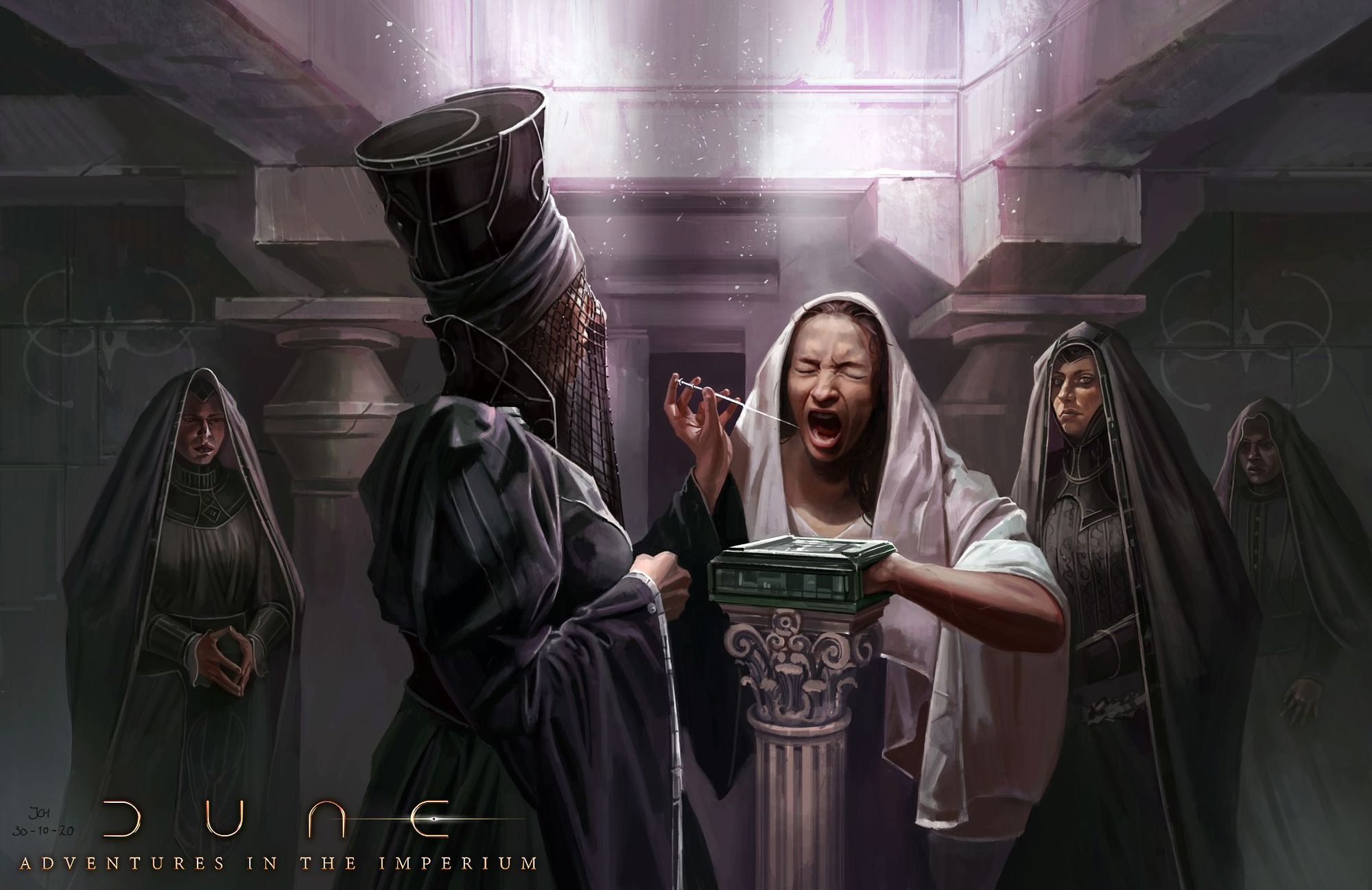
Creating the Look of the Dune RPG
Artistically, the challenge was every bit as daunting. Unlike many of Modiphius’s other licensed games, there’s no single visual language that defines the world of Dune. From trippy 1960s book covers to the even trippier vision for Alejandro Jodorowsky’s near-mythical unmade adaptation, to David Lynch’s baroque grotesque and the moody noir of Denis Villeneuve, everyone has something different in their mind’s eye.
This was a challenge that the line’s Art Director Katya Thomas relished.
“A lot of the time I find in RPGs is you do a kind of realistic but almost stylized artwork,” she explains over Zoom. “So that’s kind of the norm. And I wanted to do something different. I wanted to capture the kind of movement and focus on the atmosphere and color and mood more than being specific about details. It lends itself well to a kind of impressionist, looser style like speed painting. We did a couple of tests with artists and if they come back and it works well, we then take that to Legendary Entertainment and say, ‘What do you think about this?’ And that’s the other thing. We wanted to differentiate ourselves stylistically from the film. And Legendary was happy with that as well.”
The result is stunning. The rolling sandstorm of the cover art draws you inside to the nervous energy of the interiors, positively dripping drama, motion, and mystery. If you love Dune already or emerge from the cinema wide-eyed and gobsmacked, Dune: Adventures in the Imperium has more than enough value as a reference guide or art book to make its way to your coffee table.
“It’s really difficult for me because I’m not an artist,” Peregrine confesses. “So I will see the art coming in as it crosses my desk in some way – crosses my inbox. I have to fight the urge to just go, ‘That’s amazing. Print it now’. I have to try and go, ‘No, be more critical’. Things like ‘Oh, hang on, those guys shouldn’t be using shields’ or ‘These people wouldn’t be standing next to those people’, or things like that. I have to fight down my initial reaction, which is usually ‘Oh my God, that’s amazing’.”
The art style that Modiphius eventually settled on for Adventures in the Imperium is another example of that perfect poise that meets the expectations of a hugely diverse audience. Taking the visual language of the movie as a starting point and then adding elements and interpretations of their own in order to end up with the seemingly impossible – something instantly familiar and completely unique.
“That was definitely a challenge from the beginning,” says Thomas. “But we discussed with Legendary how closely we wanted to stay with their visual reference. And they actually gave us a huge, like, 300-page style guide for what they were doing with the movie, which was incredibly helpful. So we were able to reference all of the costumes. We definitely utilize the look of the Houses’ uniforms, that was really helpful to have that already done. The Sandworm, [and] the Fremen – they were all integral to sticking with the movie because we loved the design so much.
“The character illustrations at the back of the book, some of them were based a lot on the examples they gave us. So the Mentat, for example, the uniform and the tattoo is very much as it was seen in the style guide. They brought in that sci-fi industrial style, they created it so perfectly in my opinion. But I also really wanted to make sure we brought in the historical element and Arabic influences that are more prevalent in the book itself.
“When it came to more civilian-type clothing or spies, I did a lot of research into finding like clothing examples that were industrial, but at the same time had like a Middle Eastern feel. And I have huge documents of just like millions of reference pictures of like, ‘Oh, I like that’, ‘That works’, ‘That looks cool’. So we can kind of mix and match as long as it stays within the visual theme. So in any areas where maybe Legendary didn’t have references, we were able to go back to the book and say, ‘How would Frank Herbert have visualized this?’.”
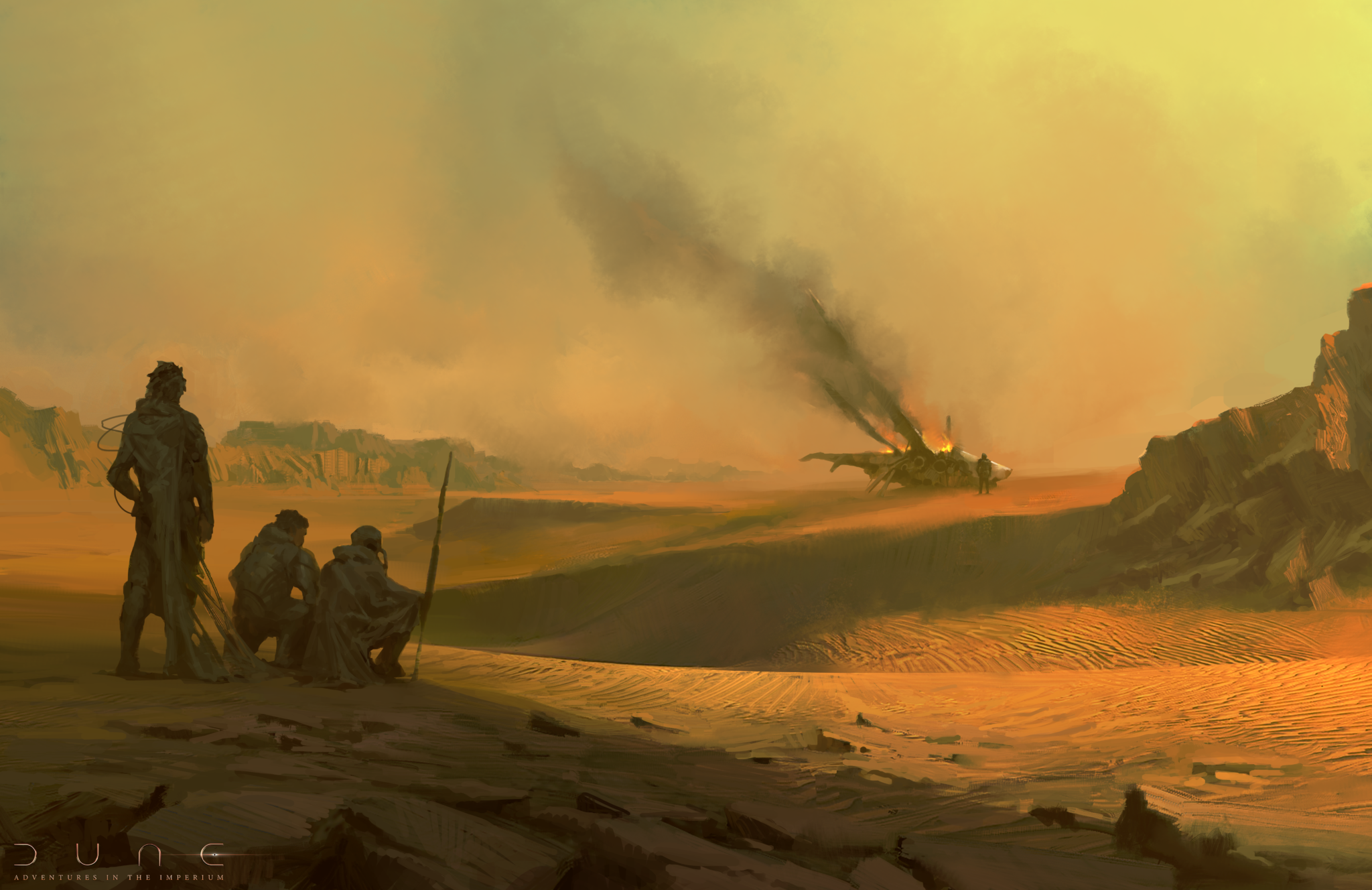
Working with the Frank Herbert Estate
A variant on that question must have been frequently posed by Peregrine, but occasionally he got an answer courtesy of the Herbert Estate.
“We don’t just get, ‘Nope, don’t like it’. They give us good feedback. Sometimes [on other projects] you send books in and they just get some marketing guy to have a look and says, ‘Yeah, that doesn’t contravene any official marketing guidelines’ and it comes back. Approvals were a bit of a long process for us, but that’s because so many people are looking at this. The Herbert Estate is reading these books. They give us some really useful feedback, which has helped us out with some of their intentions. It gives a little bit of insight into the directions they’re taking so that we can try and match what they want to see in their game.”
Given the collective lifetimes spent immersed in Frank Herbet’s vision, the estate is the final word on matters of minutiae. If you’ve never run a game in a pre-existing setting, you won’t know just how quickly you hit the limit of your knowledge. Many licensed games are forced to content themselves exclusively with what appears on the screen or the page, and the creative claustrophobia is then immediately obvious to anyone picking up the book. This isn’t the case when you have access to people who truly inhabit that world the way that only its originators can.
“I would love to just have an afternoon sit down with them and chat,” says Peregrine. “That would be phenomenal. But obviously, we can’t do that. We also can’t barrage them with questions., but in a sense, everything we send for approval does carry with it a certain amount of questions. But we do have to check things. For instance, I did have to send a note in to say, ‘Can I confirm the existence of Mauler rifles, because you only hear to hear people talk about Mauler pistols?’ There probably is a rifle version and you see pictures of people with rifles, so totally reasonable to assume there are Mauler rifles as much as there are Mauler pistols. But can we just check that?”
How to Play the Dune RPG
The Player Characters in Dune: Adventures in the Imperium are all agents of a (likely minor) noble House. This can be developed as a group, conjuring up a homeworld, traditions and culture, and history all of its own, and giving them – in and out of character – a stake in the game that goes well beyond how much gold or how many XPs you accrue. This is enhanced by the Drive mechanic, the most obvious twist on Modiphius’s 2D20 system that allows character motivations to shape the success or failure of their actions in-game.
Another cool design that reflects the way events in Dune unfold is Architect and Agent-level play. This stems from the use of Assets – resources that the character has access to that might range from a personal energy shield and blackmail material to soldiers, assassins, servants, and spies. It seems kinda obvious in retrospect because no way in hell does Paul Atreides pick up his own laundry, but a player can nominate a human Asset or Assets to attend the scene instead of him or her. In that case, they direct their Assets as an Architect behind the scenes, whilst the rest of the group might charge in as Agents. There’s no convoluted rule change to represent this, it’s just a neat little riff on classic troupe-based RPGs like Ars Magica (1987) that better reflects the way a space opera like Dune unfolds.
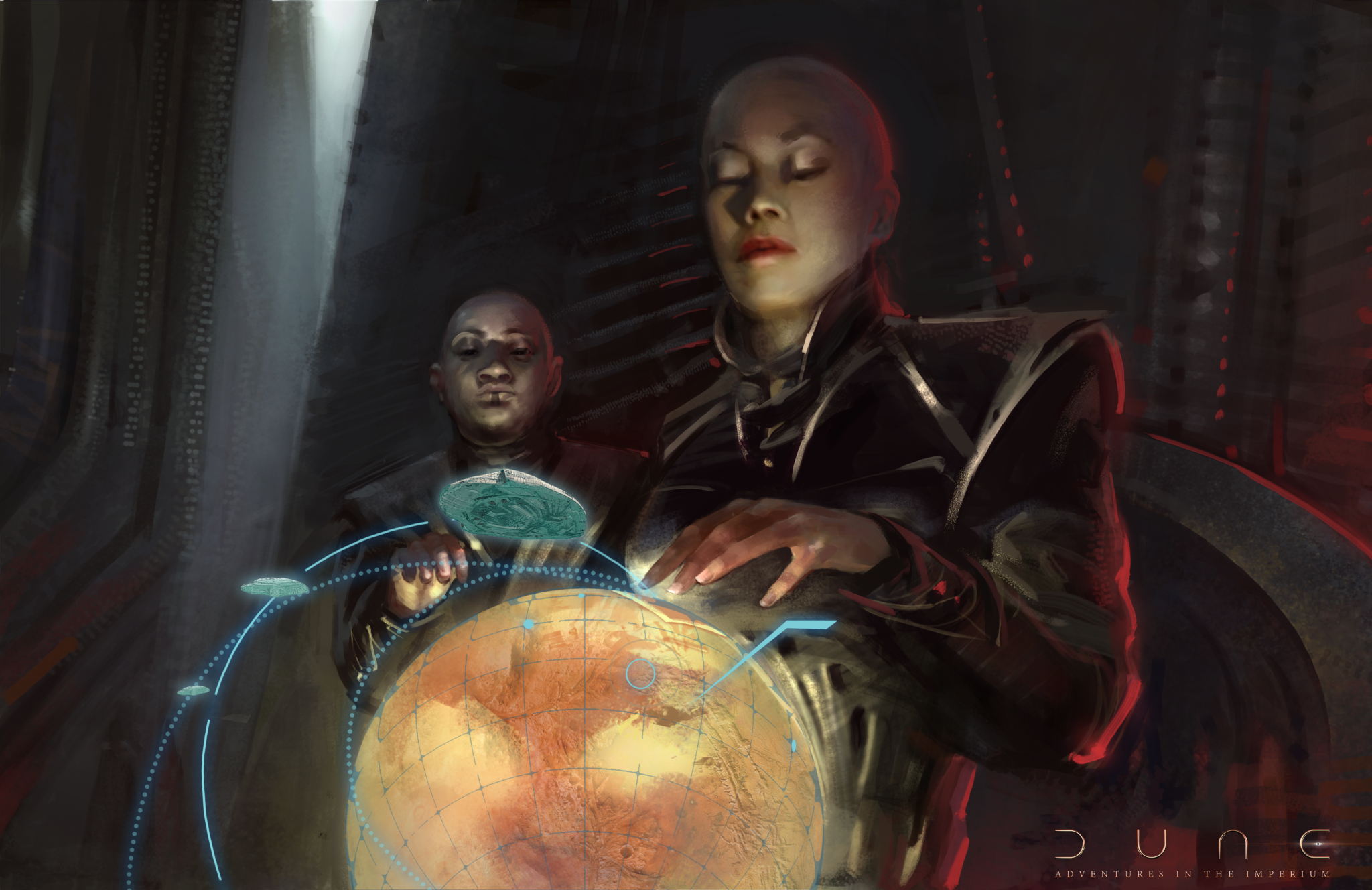
“Obviously [Lead Designer] Nathan Dowdle was the first point for Dune,” Peregrine explains, “because he’s the 2D20 system designer. It used to be back in the ‘80s so many game companies had to have their house system and the setting was spannered into it. But what I love about 2D20 – and I’ve come to love it even more working on Dune – is that it’s never ‘make the setting fit this system’, it’s is always making sure that the system is adapted and amended so that it best reflects that setting.
“What [Nathan] came up with originally was very much based on the Architect level. You have your House and your Player Characters decide what your House wants to do. And then they make some Architect-level rolls. It was almost like they’re all sitting around the table managing that House, as the core of the game. And Jason [Durall, Dune: Adventures in the Imperium Line Editor] and I really loved that idea, because it is very Dune, the idea that you reach out across the planet with your influence and your Assets. But we also thought there are times Dune is a game of epic knife battles and ornithopter rides through storms. So we knew we also had to bring in that element of what we’re now calling Agent life where you could be the boots on the ground.
“It was when we were looking at these two styles [we] realized that we had detached the physical aspect of doing any action from the action itself. So you don’t need to know how strong or dexterous you are. That’s all part of your skill, what you need to know is why you’re doing it. So once you do develop that, we could then simply apply that to the Agent’s play. But it meant we had these two modes of play that work in the same way. So a lot of people have read the book and gone ‘Oh, so what’s the difference?’ when the difference is there’s no difference at all.”
At the heart of the decision was Andrew’s experiences running Dune: Chronicles of the Imperium (2000), a game that only saw an extremely limited run due to Byzantine rights issues with publisher Last Unicorn Games and the company’s acquisition by Wizards of the Coast.
“I’m one of the few people who have played that game rather than speculate on eBay. And it’s really good. My friend Greg was playing a Mentat and every time something was going on, he would say, ‘My character goes into the security control booth and I’m going to be watching on the monitors’. And I thought, after a while, I thought, ‘Am I failing him as a GM here because he’s never involved in what’s going on? Have I screwed it up? Am I not giving his character a good option to get involved?’ So I chatted to him after one of the sessions and said ‘Are you alright with the way things are going?’ And he was like, Yeah, I just think it’s cool being the Mentat’. He just loved inhabiting his character, imagining himself, watching the screens, and seeing things happen as if he was like the spy or puppet master. So it was very much in my head [developing Adventures in the Imperium], I wanted to give Greg’s character something to do because it was a very Dune way he was playing.”
Sand and Dust: The Arrakis Sourcebook
It’s a concept that deserves to be explored with more tips and advice because it marks the most radical departure from what your average Dungeons & Dragons player might be expecting, but Andrew is forthright that it won’t fundamentally alter the mechanics. The core book for Dune: Adventures in the Imperium should be – and is – everything you need to start straddling Sandworms and kicking off a coup d’etat. (“If you can’t play this game with just the core rulebook ‘til Doomsday, we haven’t written the core rulebook correct,” he says.) What later releases will do is bring depth to each setting or theme, starting of course with Dune itself in Sand and Dust: The Arrakis Sourcebook – which is available for pre-order now and expected to ship in December.
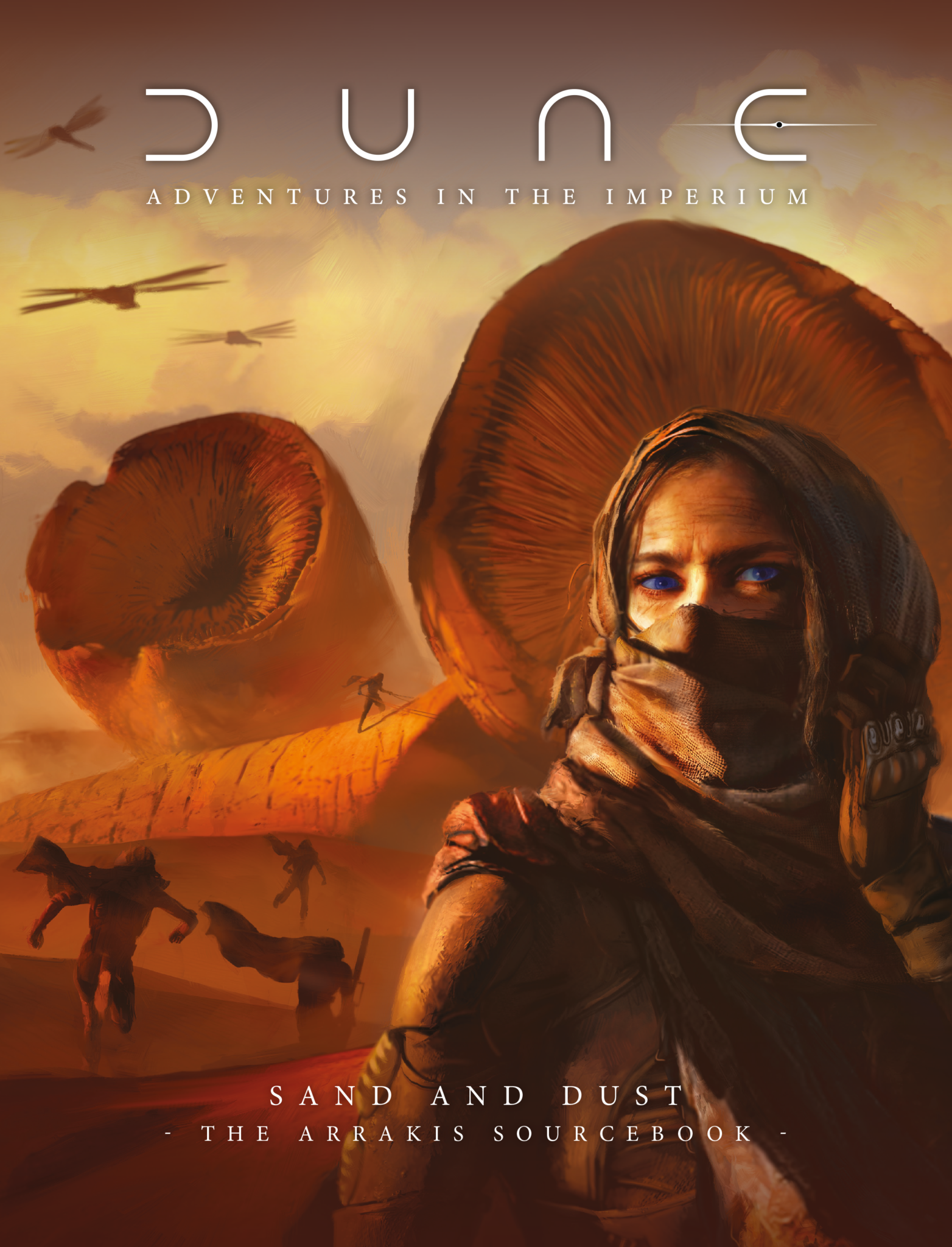
“How we can support those things is [with] more Assets and more advice. As we go into the various books, I am planning for us to have at least a little bit for each, as you’ll see in Sand and Dust. We have a lot about the Fremen in there. For all of those Faction characters, there are later books. We will have some more options for Guild characters, [and] Bene Gesserit characters. All of those components are something we can expand on in the right place. So don’t take this as a reveal, but if we have a book that involves more society, that’s a good place to expand the Assets for intrigue. If one involves a war between the Houses or something, we can have a look at the warfare aspect and how you do that. There’s a lot of advice we can have, but the key is Assets: how you use them, what new Assets could you acquire and how can you acquire them. It’s an ever-developing thing. I quite like to have each supplement having its own theme [and to] have a solid basis. You don’t want that to be just another collection of stuff.
“Hopefully you’ll see this in the Sand and Dust book. I’m a big, big fan of deserts as a… thing. Whilst they are horrifically dangerous, there is life. You look at the rolling sand dunes, there are little scorpions and all plants that live in the desert that can live in these incredibly hostile conditions. And there is a beauty to that. The way the dunes roll off into the distance, the way these twin moons will set over the panoramic horizon. It’s a beautiful planet and a lot of people write it off. One thing I loved in one of the recent trailers is it starts with Chani, talking about how beautiful it is. Something that’s often skirted over, because you’re like, ‘Oh, this is a hot, sandy, horrible place’. Every place has got its own beauty and the natives of Arrakis can see that.
“Frank Herbert wrote so much about how this planet fits together. There are so many secrets on Arrakis. Secret hideaways for the Fremen, secret research facilities, the ecological plots going on, plus of course, where Spice comes from that the people and nothing about. It is staggering how little the Imperium knows about actual Spice, how little it cares because as long as it keeps coming, nobody wants to see the source.”
For Thomas, the enigmatic nature of the Freman and their world left a massive amount of creative space that she could step into with her army of illustrators and her bulging file of Middle Eastern and North African references.
“We look a bit deeper into the Fremen and their lifestyle, which I found interesting because they’re so elusive and quite mysterious. So there wasn’t always a huge amount of information on them. I looked at some of the historical elements thinking about what was prevalent in the Middle East back in Mediaeval times, what cultural things were prevalent, like different kinds of dances or ceremonies, and felt that it would be so fitting for the Fremen to be doing that sort of thing as well.”
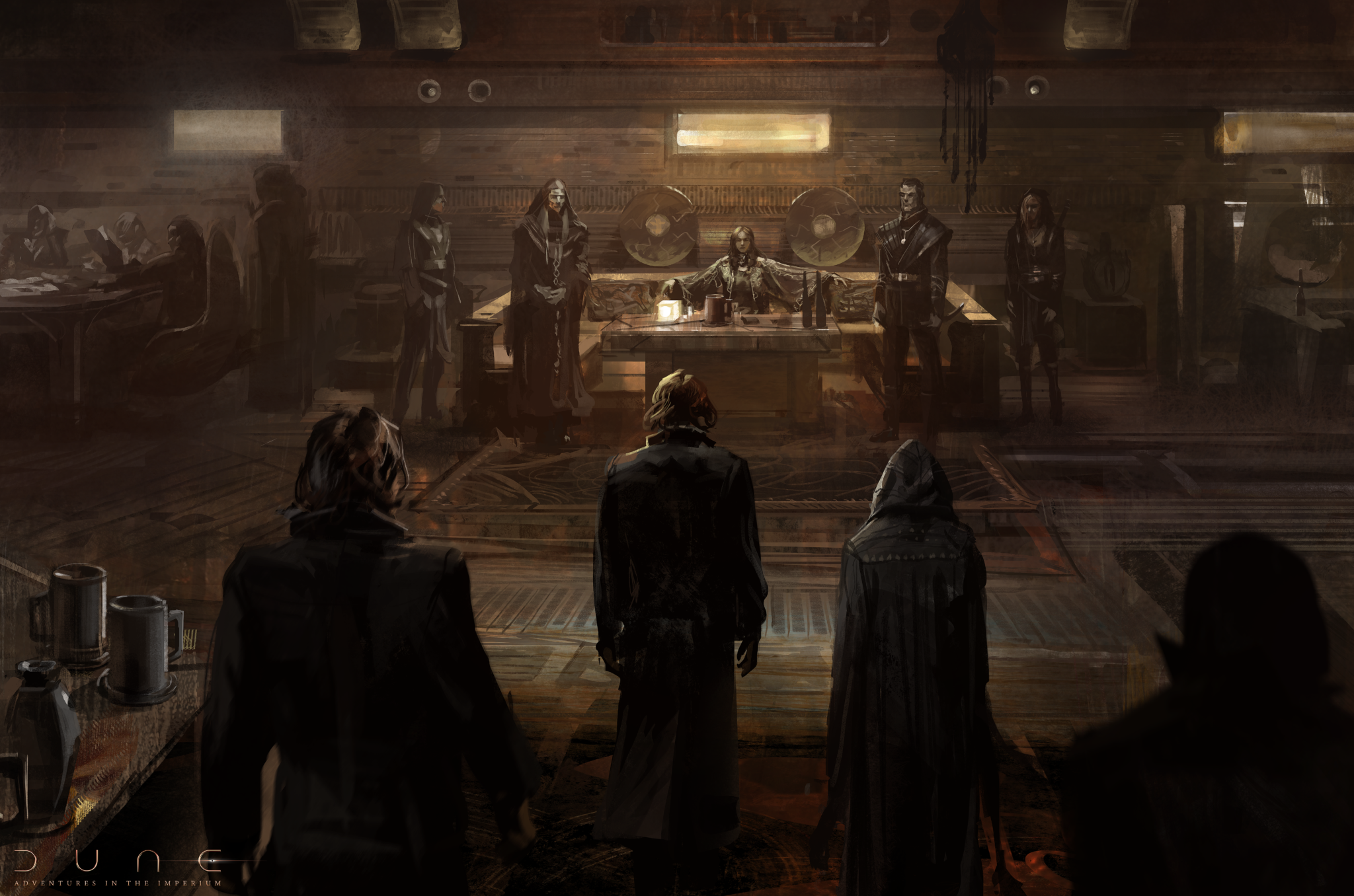
Arrakis Goodbye
It’s an amazing sandbox (sorry) to play in, but neither Andrew Peregrine nor Katya Thomas – nor, I suspect, the rest of their colleagues – take for granted what a small (but perfectly formed) part of a larger beast Dune: Adventures in the Imperium is.
“And it’s so personal to each reader as well,” explains Thomas. “I remember when I first told friends that I’d be working on Dune and they were like, ‘Oh my God, I would be scared’. Because it’s so different for everyone. So I just wanted to make sure we could stay as true to the novel as possible, but also leave room for interpretation as well for the actual players and fans.”
“We have to keep remembering,” says Peregrine, “this is a property that belongs to the Herbert group and Legendary. And we are very privileged to be able to use it and do a game based on it, but they are not just soulless corporations receiving money – they love this too. This setting is very important to them because in the case of Legendary, they have created this film that is a work of art. It’s their art and it is phenomenal. And of course, the Herbert Estate is creating these novels and they wouldn’t have made so many if they didn’t love this setting. It belongs to them.
“We are very privileged to be literally in their garden, wandering around doing stuff. So it’s wonderful as a fan to see how much care and concern they have for what we’re doing. And it’s wonderful to be you know, with them on that journey for a little bit.”
This article was first published on September 16th, 2022, on the original Companion website.
The cost of your membership has allowed us to mentor new writers and allowed us to reflect the diversity of voices within fandom. None of this is possible without you. Thank you. 🙂







